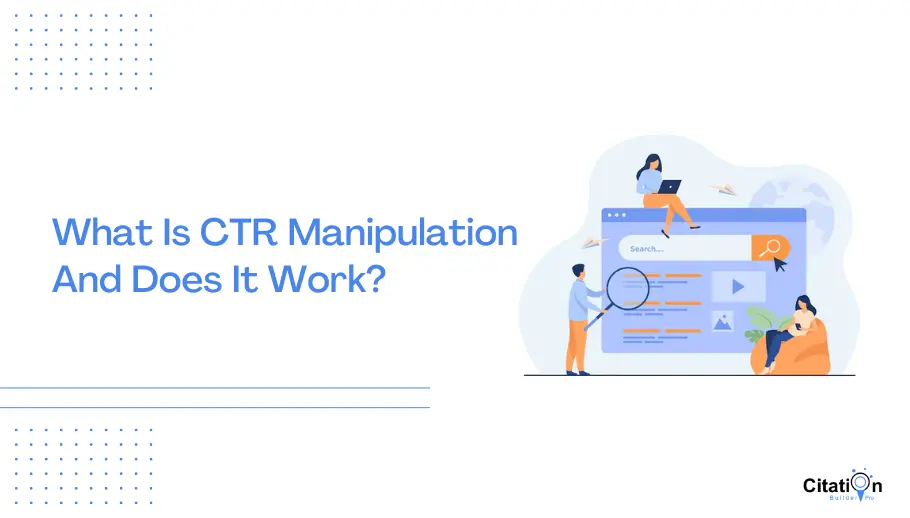GMB CTR Manipulation: Boost Your Google My Company Rankings
GMB CTR Manipulation: Boost Your Google My Company Rankings
Blog Article
Checking Out the Partnership Between CTR Control Services and User Behavior
In the realm of digital marketing, the impact of click-through price (CTR) adjustment services on user habits stays a complicated and intriguing topic. By exploring the elaborate relationship between CTR control solutions and customer actions, appealing understandings emerge that may reshape our understanding of digital advertising and marketing approaches and their results on customers.
Impact of CTR Adjustment on Habits
Evaluating the impact of Click-Through Rate (CTR) adjustment on customer actions discloses essential insights right into the dynamics of online engagement. CTR adjustment involves synthetically pumping up the variety of click a certain web link or advertisement to deceive customers and online search engine. This practice can result in an altered perception of a webpage's appeal or relevance, ultimately influencing customer habits.

In addition, CTR control can alter the information used by formulas to customize individual experiences. This can lead to customers being offered material that does not line up with their preferences or passions, inevitably causing a decrease in user satisfaction and involvement. Recognizing the effect of CTR adjustment on customer behavior is vital for preserving transparency and rely on on the internet communications.
User Engagement With Adjusted CTR
Customer interaction with adjusted CTR information commonly leads to manipulated perceptions of online content popularity and significance. When customers engage with material based on unnaturally inflated Click-Through Fees (CTR), they may think that specific info, products, or solutions are a lot more prominent or trustworthy than they actually are. This can lead to customers making decisions based on misleading information, bring about possibly negative results.
Engagement metrics like sort, shares, remarks, and time spent on a web page are commonly affected by CTR control. Users might be much more inclined to engage with material that appears to have greater interaction rates, further continuing the cycle of manipulated perceptions. Because of this, content designers and advertisers might focus on generating web content that produces high CTR rather than concentrating on creating genuinely useful and pertinent material.

Mental Effects of CTR Adjustment

Additionally, the emotional results of CTR control can also show up in altered decision-making procedures. Individuals may be more inclined to click on content only based upon its regarded appeal, instead than its actual value or significance to their demands. This behavioral change can result in a superficial interaction with ctr manipulation press release on the internet content, where individuals may ignore premium yet less prominent offerings for those with synthetically improved CTRs.
Essentially, the psychological ramifications of CTR control highlight the relevance of preserving openness and authenticity in on-line communications to cultivate authentic customer involvement and count on.
Honest Considerations in CTR Adjustment
CTR control raises worries about deceiving customers, distorting data analytics, and endangering the credibility of online content. By synthetically inflating CTR, users may be misled right into clicking on links or ads they would certainly not have actually chosen otherwise, leading to a disingenuous online experience.
One more honest element to contemplate is the justness of adjusting CTR to get an unreasonable benefit over competitors. Participating in such techniques not only breaks principles of justice yet likewise undermines the count on that individuals place in on the internet systems. It is essential for businesses and electronic marketing experts to maintain moral criteria in their techniques to make certain transparency, reputation, and lasting sustainability in the on-line setting.
Effects for Digital Advertising And Marketing
With the enhancing dependence on electronic platforms for advertising and marketing objectives, the method of manipulating click-through rates (CTR) presents significant ramifications for the effectiveness and stability of digital advertising strategies. CTR control can bring about manipulated data analytics, misdirecting marketers right into believing that their campaigns are executing much better than they really are. This can lead to misallocation of resources, with business spending in underperforming strategies based on falsified CTRs. When users understand that CTRs have been adjusted, it can wear down count on in the brand name, leading to long-term adverse repercussions for consumer commitment and brand name credibility.
Furthermore, the use of CTR control services can produce an unreasonable competitive landscape, where business that involve in such practices get a fabricated advantage over those that adhere to ethical advertising criteria. This can stifle development and creativity in digital advertising, as success comes to be more concerning adjustment tactics than providing authentic value to consumers. Inevitably, the implications of CTR manipulation for digital advertising extend past temporary gains, affecting the general sustainability and reputation of advertising efforts in the digital realm.
Conclusion
Finally, the partnership in between CTR control services and individual behavior is complicated and complex. The effect of CTR adjustment on behavior, user engagement with adjusted CTR, emotional effects, ethical considerations, and effects for electronic advertising and marketing all play a role fit this connection. Comprehending these characteristics is vital for marketers and researchers alike in order to browse the moral ramifications and optimize the effectiveness of their electronic advertising and marketing strategies.
Report this page